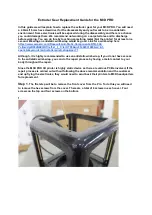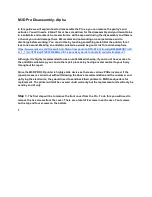
TH210
Programmer’s Guide
69
Real time commands
The real time commands provide an application interface to the printer even when the printer is
not handling other commands (RS-232C communication interface only):
Real time status transmission: GS (Hex 1D) sequence and DLE (Hex 10) sequence
Real time request to printer: GS (Hex 1D) sequence and DLE (Hex 10) sequence
Real time printer status transmission
The batch mode printer status commands are placed in the printer’s data buffer as they are
received and handled by the firmware in the order in which they were received. If the paper
exhausts while printing data that was in the buffer ahead of the status command, the printer goes
busy at the RS-232C interface and suspends processing the data in the buffer until paper is
reloaded. This is true for all error conditions: knife home error, thermal printhead overheat, etc. In
addition, there is no way to restart the printer after a paper jam or other error, when using batch
mode status commands.
The real time commands are implemented in two ways in order to overcome the limitations of
batch mode status commands. Both implementations offer the same functionality; which one you
choose depends on the current usage of your application.
Preferred implementation
For a new application the GS (1D) sequences are recommended to avoid possible
misinterpretation of a DLE (0x10) sequence as a clear printer (0x10 0, ASCII DLE NUL) command.
An application using these GS (1D) sequences, does not need to distinguish for the printer
between the new real time commands and the clear printer command. This implementation is
ideal for an existing application that already uses the clear printer command or for a new
application being developed.
Alternate implementation
The alternate implementation uses the DLE (0x10) sequences as implemented on other printers.
An application using these DLE (0x10) sequences and the original clear printer command (0x10)
must distinguish for the printer between the new real time commands and the clear printer
command by adding a NUL (0x00) to the clear printer command.
An application using these DLE (0x10) sequences must also send the second byte of the sequence
within 100 milliseconds of the first, to prevent the first byte being mistaken for a clear printer
command.
Rules for using real time commands
Three situations must be understood when using real time commands.
First, the printer executes the real time command within a few msec of detecting it in the input
buffer and will transmit status regardless of the condition of the DSR signal.
Second, the printer transmits status whenever it recognizes a real time status transmission
command sequence, even if that sequence happens to occur naturally within the data of another
command, such as graphics data.
In this case the sequence will also be handled correctly as the graphics data it is intended to be
when the graphics command is executed from the buffer.
Third, care must be taken not to insert a real time command into the data sequence of another
command that consists of two or more bytes.
Summary of Contents for TH210
Page 1: ...TH210 Thermal Printer Programmer s Guide December 2015 ...
Page 123: ...TH210 Programmer s Guide 119 Character code table Page 1 PC850 Multilingual Latin I ...
Page 124: ...TH210 Programmer s Guide 120 Character code table Page 2 PC852 Latin II ...
Page 125: ...TH210 Programmer s Guide 121 Character code table Page 3 PC860 Portuguese ...
Page 126: ...TH210 Programmer s Guide 122 Character code table Page 4 PC863 Canadian French ...
Page 127: ...TH210 Programmer s Guide 123 Character code table Page 5 PC865 Nordic ...
Page 128: ...TH210 Programmer s Guide 124 Character code table Page 6 PC858 Multilingual I Euro ...
Page 129: ...TH210 Programmer s Guide 125 Character code table Page 7 PC866 Russian ...
Page 130: ...TH210 Programmer s Guide 126 Character code table Page 8 WPC1252 Latin I ...
Page 131: ...TH210 Programmer s Guide 127 Character code table Page 9 PC862 Hebrew ...
Page 132: ...TH210 Programmer s Guide 128 Character code table Page 10 PC737 Greek ...
Page 133: ...TH210 Programmer s Guide 129 Character code table Page 11 PC874 Thai ...
Page 134: ...TH210 Programmer s Guide 130 Character code table Page 12 PC857 Turkish ...
Page 135: ...TH210 Programmer s Guide 131 Character code table Page 13 WPC1251 Cyrillic ...
Page 136: ...TH210 Programmer s Guide 132 Character code table Page 14 WPC1255 Hebrew ...
Page 137: ...TH210 Programmer s Guide 133 Character code table Page 15 KZ_1048 Kazakh ...
Page 138: ...TH210 Programmer s Guide 134 Character code table Page 16 WPC1254 Turkish ...
Page 139: ...TH210 Programmer s Guide 135 Character code table Page 17 WPC1250 Central Europe ...
Page 140: ...TH210 Programmer s Guide 136 Character code table Page 18 WPC28591 Latin 1 ...
Page 141: ...TH210 Programmer s Guide 137 Character code table Page 19 WPC28592 Latin 2 ...
Page 142: ...TH210 Programmer s Guide 138 Character code table Page 20 WPC28599 Turkish ...
Page 143: ...TH210 Programmer s Guide 139 Character code table Page 21 WPC28605 Latin 9 ...
Page 144: ...TH210 Programmer s Guide 140 Character code table Page 22 PC864 Arabic ...
Page 145: ...TH210 Programmer s Guide 141 Character code table Page 23 PC720 Arabic ...
Page 146: ...TH210 Programmer s Guide 142 Character code table Page 24 WPC1256 Arabic ...
Page 147: ...TH210 Programmer s Guide 143 Character code table Page 25 WPC28596 Arabic ...
Page 148: ...TH210 Programmer s Guide 144 Character code table Page 26 KATAKANA Asia ...
Page 149: ...TH210 Programmer s Guide 145 Character code table Page 27 PC775 Baltic ...
Page 150: ...TH210 Programmer s Guide 146 Character code table Page 28 WPC1257 Baltic ...
Page 151: ...TH210 Programmer s Guide 147 Character code table Page 29 WP28594 Baltic ...
















































